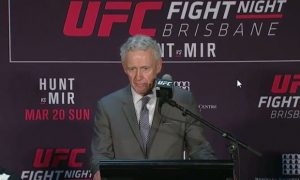New regulations, an evolution of their image and a massive social media and content strategy has ensured that the Ultimate Fighting Championship (UFC) is one of the most valuable sports properties on the planet. Their athletes have become international, mainstream sports stars which has helped to drive UFC’s growth.
The growth from fledgling promotion to mainstream was completed in July when UFC fetched a $US4 billion price tag when sports and entertainment giant WME-IMG led a takeover group to buy the promotion from UFC’s majority owners brothers Lorenzo and Frank Fertitta.
While domestically business is booming. The much talked about UFC 193 held at Etihad Stadium in Melbourne in November 2015 grossed $9.65 million at the gate off the back of a UFC record attendance of 56,214. That attendance eclipsed the previous highest single-event attendance of 55,724 set at UFC 129 in Toronto, Canada.
Helping to drive these events locally is Tom Wright, who is UFC’s Executive Vice-President and General Manager for Australia, New Zealand and Canada. Wright leads operations and development of the UFC brand and business across the three markets. His position calls for supreme negotiating skills, especially as different jurisdictions have or did away with octagon bans, and the need to drive significant pay-per-view, broadcast and sponsorship business in each market.
With 35 years experience in the sports industry, Wright spent four years as Commissioner for the Canadian Football League and was President at Salomon North America, adidas Canada and Spalding Canada.
He spoke to Sports Business Insider about UFC’s local operations, working with Australian state governments and what makes the promotion the preeminent MMA company in the world.
Can you offer insight into plans to entrench UFC as the leading mixed martial arts (MMA) promotion in the Australian and New Zealand market? Keeping in mind there is competition from the likes of Bellator and ONE Championship in a competitive space.
“Wherever we are in the world there’s always competition but our approach has always been to be the premier, number one and most progressive MMA organisation in the world and we take that seriously in all of the markets that we compete in. We feel strongly that if you position yourself as the best and you deliver on providing the best environment for your athletes to compete, the best events for them to display their skills and athleticism as a mixed martial artist and provide them with the highest level of competition, then you’ll continue to be the most elite MMA company in the world.
“It’s no small wonder that the best athletes in our sport want to compete with the UFC as they know they’re going to be tested to the highest degree.”
The way UFC has raised their image as a mainstream sport, has that helped raise the legitimacy of pursuing MMA as an athletic pursuit?
“I agree completely and in the end if you are a world-class professional athlete, regardless of the sport, you always aspire to have that pathway to excellence and that pathway is going to allow you to compete for a world championship at the highest level.
“If you’re a professional mixed martial artist the only ‘Australian Open/Wimbledon’ of our sport is a pay-per-view event that might happen in Las Vegas.”
UFC has been fortunate to take become the pinnacle promotion despite all competition.
“We’ve always had that position. Competition is going to come and they have their own positioning but we don’t spend a lot of time looking into the rearview mirror, we have to look forward and build upon our position as the preeminent MMA organisation in the world. How do we build upon that? We do that by taking our sport into new places, by holding a stadium event in Victoria, who would have thought that we would get 56,000 people into a footy stadium (Etihad Stadium) and feature a main event and co-main event featuring four women.”
Did the success of that event, UFC 193, surprise head office?
“I think they were pleasantly surprised. I’ve spent the last three and a half years working on our Australian business, travelling to the country many times and I know we have a really strong fan base there, we’ve got passionate, smart, engaged, knowledgeable fans that we felt that if we brought them a world-class event that fans across the entire country would come.
“There’s a reason why Melbourne is the sporting capital of the world! Formula One, Melbourne Cup, the first tennis Grand Slam of the year, Australian’s and Victorian’s are lovers of great sport.”
Do you believe there are nuances with marketing big events and engaging fans in Australia and New Zealand? And trying to deliver an event that has a local feel to it.
“Absolutely there are but there’s a couple things I could say to that. One of the nuances is providing an opportunity for local athletes to compete on a global stage. Fighters like Jake Matthews, who is very young, in his early 20’s and from Melbourne having a chance to compete in front of his hometown I think was really important. The same with Dan Kelly, who was at the other end of his career, a four-time Olympic judoka Australian representative, and for him that’s what we want, an opportunity to compete in front of his family and friends in his home country because Australian’s, like Canadians, we like to cheer for our own.
“I bring up an example of an event we had in New Zealand where they performed the haka and there’s never been a haka performed before a fight before. It was a little hat tip to what makes sport special and unique to New Zealand. The crowd loved it.”
Just staying with the Australian and New Zealand market, how economically important are they as both a PPV market and a live audience market?
“Right now Australia and New Zealand together rank fourth or fifth in the world, which is a pretty big number when you consider the size. On a buy-rate percentage – we have different metrics we use around the world. How many pay-per-view buys per 1000 people. On a PPV buy-rate, Australia has the highest buy-rate in the world.”
You had success in Canada, but can you shed some light on the challenges of getting MMA fights legalised and sanctioned in Australia? Has it been a delicate process?
“Delicate is the wrong word. It’s been a very frustrating and in many ways bewildering challenge. And I’ll tell you quite specifically, there were two states, Victoria and Western Australia, and only one now (Western Australia) that we’ve had huge challenges with.
“In Victoria, the state has always sanctioned and regulated professional MMA but since 2008 they have only allowed competition in a boxing ring. Up until 2015 we’ve spent the better part of six to seven years trying to convince the then Liberal government to change their policy on our sport to no avail. It was only when we convinced the then opposition government, which back in 2014 was Labor, to adopt a policy if they were elected to lift the octagon ban. And once they agreed to that policy we said if you lift the ban we’ll bring a major event to Victoria.
“In November 2014, the Labor government under Daniel Andrews was successful and three months later in March they lifted the octagon ban and lived up to their commitment, and on that same day we lived up to our commitment and said ‘we’re going to bring a major event to Victoria.’ And we brought UFC 193 to Melbourne.
“That process took the better part of five years and it was crazy! A lot of people thought that MMA was banned except you just couldn’t compete in an octagon. At the heart of our argument was that we only will allow our athletes to compete in an environment that’s safe and fair. Allowing mixed martial artists to compete in a boxing ring is not only unfair but more importantly unsafe. Athletes and referees can be thrown under, over or between the ropes.
“At the heart of our regulatory efforts it has always been the health and safety of the athletes. We were successful in having the octagon ban lifted in Victoria. We face the same issue now in Western Australia. The current Premier of WA (Colin Barnett) has no intentions of lifting the octagon ban. Those are the challenges that we face. But it is a matter of when not if.”
If WA lifts the ban, would you bring an event over to the state?
“Absolutely, and that’s a commitment we would make. Perth Arena is a lovely arena it would be perfect for a UFC event.”

Tom Wright on bringing an event to Perth, Western Australia: “Absolutely, and that’s a commitment we would make.” Image: www.fightnewsaustralia.com
In your opinion then, how should UFC innovate as a brand to ensure that it remains the number one MMA promotion?
“Innovation is part of our DNA. We innovate in terms of how we produce our events, we’re starting to produce them in 4K, virtual reality as well. We innovate in terms of embracing digital and social media. We think we’ve been innovative in terms of our commitment to providing a fair and drug-free environment for our athletes to compete in.
“You can see how we’ve extended our brand beyond the octagon to a partnership with EA Sports. We’ve partnered with one of the largest gym organisations in the world and are taking UFC gyms to cities around the world, we have one already in Sydney but we’re looking to expand them around Australia.
“We introduced Fight Pass two-and-a-half years ago. That’s our over-the-top content distribution methodology. We have one of the largest MMA/combat sports libraries in the world available on Fight Pass which includes K-1, jiu jitsu, wrestling, boxing. A lot of content people might not have ever seen.”
The post Outside the Octagon: One on One with Tom Wright appeared first on Sports Business Insider.

